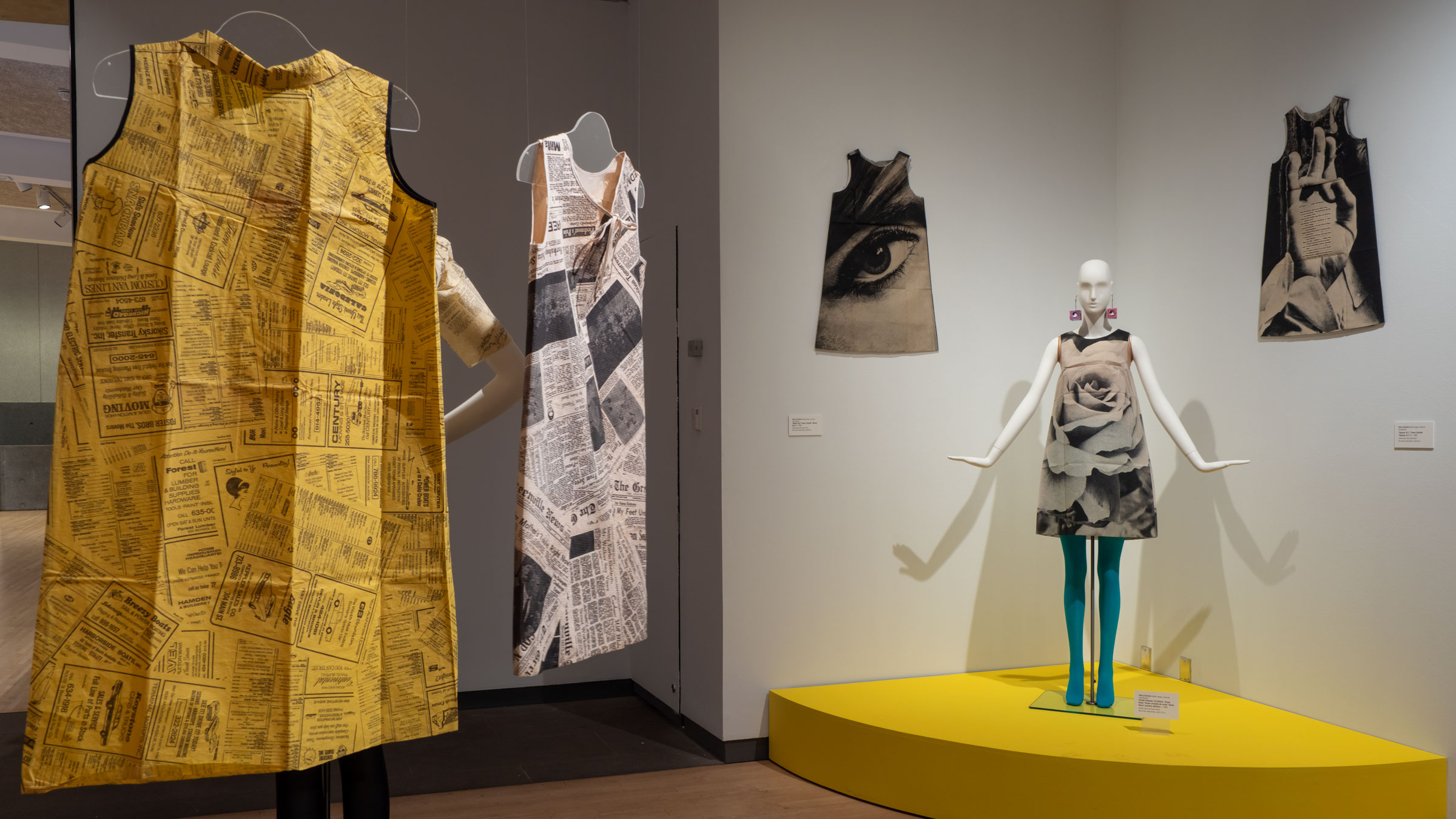Get the Latest News
Museum of Arts and Design Exhibition Explores Whimsical and Experimental World of 1960s Paper Fashion
Generation Paper: A Fashion Phenom of the 1960s
March 18–August 27, 2023

Image—Installation view of Generation Paper: Fast Fashion of the 1960s, 2021, Phoenix Art Museum. Image © Phoenix Art Museum
New York, NY (January 19, 2023)
On view from March 18 to August 27, 2023, at the Museum of Arts and Design (MAD), Generation Paper: A Fashion Phenom of the 1960s explores the era’s short-lived phenomenon of paper fashion through more than 80 rare garments and accessories crafted from non-woven textiles. These fashions, introduced in 1966 as a promotional campaign for Scott Paper Company, combined bold, graphic design with space-age innovations in materials. Surfacing a little-known chapter in the history of design, Generation Paper illuminates the creative partnerships of craft and commerce in the development of semi-synthetic and synthetic materials.
“Before there was fast fashion, there was paper fashion, which ironically was meant to be a demonstration of paper’s potential to behave like woven fabric,” said Elissa Auther, MAD’s Deputy Director of Curatorial Affairs and William and Mildred Lasdon Chief Curator. “Women who ordered the patterns and confidently wore paper dresses—as many did!—beautifully ushered in a new wave of cutting-edge material innovation.”
Originating from Phoenix Art Museum and primarily drawn from works in the museum’s comprehensive fashion-design collection, Generation Paper explores how the iconic silhouettes and styles of 1960s fashion—from A-line mini dresses to bikinis—became daring demonstrations of the durability and design potential of the era’s innovative paper-like materials, such as rayon (a cellulose fiber), polyester, and other synthetic blends.
Exhibition highlights include: garments that mimicked kitchen countertop and carpet patterns from a promotion for appliance manufacturer Viking; a knitted paper mini dress by Mars of Ashville; a trio of dresses, part of graphic artist Harry Gordon’s Poster Dresses series and featuring arresting black-and-white photographic images; Campbell Soup Company’s “Souper Dress” with a soup-can motif that tapped into the public’s knowledge of Andy Warhol’s pop-art screenprints; and early examples of the dresses from the Scott Paper Company marketing campaign that fueled the demand for paper fashion and inspired other manufacturers and designers to produce their own lines.
“The fashion-design collection at Phoenix Art Museum is home to a rare—and an enviable—selection of paper garments from the 1960s. These garments, including many gifted by longtime museum supporter Kelly Ellman, are in incredible condition and, in some cases, were donated in sealed packaging, never-before opened by the original owner. As a result, audiences get to experience them in pristine form,” said Helen Jean, Phoenix Art Museum’s Jacquie Dorrance Curator of Fashion Design and curator of the exhibition. “These whimsical garments transport us back to a moment when fashion happened to be a playground for testing new paper and non-woven materials. They also remind us of a time in history defined by the Space Race, counterculture phenomena, and formative social and political movements, all of which informed their designs.”
During the exhibition’s run, MAD will host several public programs designed to extend and complement Generation Paper’s content, including a curators’ talk and a series of hands-on, artist-led workshops that will invite participants to transform paper trash into one-of-a-kind fashion accessories, design textiles made of paper, and explore the Japanese art of paper clothing using traditional methods of kamiko, washi, and takuhon-shi.
EXHIBITION CREDITS
Generation Paper: A Fashion Phenom of the 1960s is organized by Phoenix Art Museum. The exhibition is made possible, in part, by public funds from the New York City Department of Cultural Affairs in partnership with the City Council and the New York State Council on the Arts with the support of the Office of the Governor and the New York State Legislature.
ABOUT THE MUSEUM OF ARTS AND DESIGN
The Museum of Arts and Design (MAD) champions contemporary makers across creative fields and presents the work of artists, designers, and artisans who apply the highest level of ingenuity and skill. Since the Museum’s founding in 1956 by philanthropist and visionary Aileen Osborn Webb, MAD has celebrated all facets of making and the creative processes by which materials are transformed, from traditional techniques to cutting-edge technologies. Today, the Museum’s curatorial program builds upon a rich history of exhibitions that emphasize a cross-disciplinary approach to art and design, and reveals the workmanship behind the objects and environments that shape our everyday lives. MAD provides an international platform for practitioners who are influencing the direction of cultural production and driving twenty-first-century innovation, and fosters a participatory setting for visitors to have direct encounters with skilled making and compelling works of art and design. For more information, visit madmuseum.org.
For high-resolution images, visit the MAD’s press image archive: http://press.madmuseum.org/
User ID: mad
Password: media
Folder: Generation Paper
#GenerationPaperMAD @madmuseum
Contacts
Wendi Parson
+1 212 299 7749
wendi.parson@madmuseum.org
Additional Contact
Iman Nelson
+1 212 299 7733
press@madmuseum.org